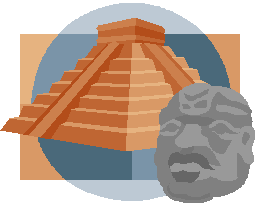Vacation in the Ancient Americas!
A WebQuest for 8th Grade Social Studies
Tiffany Danko
Travis Wall

Introduction
This lesson was developed in conjunction with EDTEC 570 and as an enrichment activity for 8th Grade Social Studies.
The lesson is introduce students to the characteristics of ancient Americas civilizations, particularly the Aztec, Inca, and Mayans. Students work in groups, using a webquest to explore characteristics of these civilizations, such as geographic, social structure, and agriculture. Students synthesize and apply their understanding by developing materials targeted at encouraging a Time Travel Vacation.
Learners
Describe the grade level and course that the lesson is designed to cover. For example: "This lesson is anchored in seventh grade language arts and involves social studies and math to a lesser extent." If the lesson can easily be extended to additional grades and subjects, mention that briefly here as well.
Describe what the learners will need to know prior to beginning this lesson. Limit this description to the most critical skills that could not be picked up on the fly as the lesson is given.
Curriculum Standards
What will students learn as a result of this lesson? Describe the outcomes succinctly. Use the language of existing standards. For example:
Social Studies Standards Addressed
- Recognize the relationships among the various parts of a nation's cultural life.
- Learn about the mythology, legends, values and beliefs of a people.
Most lessons don't just teach a block of content; they also implicitly teach one or more types of thinking. In addition to describing learning outcomes within traditional subject areas, describe what kind of thinking and communications skills were encouraged by this lesson. Inference-making? Critical thinking? Creative production? Creative problem-solving? Observation and categorization? Comparison? Teamwork? Compromise?
Process
-
Part 1 Researching
- In your groups, brainstorm on what you already know about your assigned culture, the Aztec, Inca, and Mayans. When did they live? Where were they? What were their cultures like?
- Now think about the specific things you will need to know, as a Time Tours, Inc. guide in order to encourage people to take your time-travel tour. What will you need to know about when you get there? Some things include:
- Social structure, including class
- Family life
- The arts
- The economy
- Agriculture
- Religion
- Warfare
- Slavery
- Geography and its effect on the civilization
- Astronomy
- Math
- The rise and fall on the civilization
- Remembering that your group will be developing a brochure and PowerPoint presentation for Time Tours Inc, write down all the topics you plan to research.
- In your groups, choose roles. You are all guides, but many of you have specialties. Someone is the leader of the expedition itself: this person will guide the group as a whole. Another is a biologist, someone is an economist, and another is a historical researcher. Someone else specializes in religion, and one of you has a passion for military history. How do each of you feel as guides- what will you need to research in order to ensure that your specialty is represented in the information presented to time tourists?
- Now begin your research, using some of the resources here. Ensure that you are noting the information you've discovered on the explorer's journal included for you to use a guide. Use the MLA format as a guide for annotating bibliographic or website information.
| Some Culture-Specific Link Compilations for you to Use | General Sources for Ancient Americas Information |
| Aztec | The Smithsonian Institution |
| Inca | National Geographic |
| Mayan |
Time Tours Inc. Guide Journal
Click on image to download word template
Click on image to download web page for journal
Part 2 Compiling
- Now each group should collect their information and compile it into an organization profile of the assigned civilization, describing life in the ancient Aztec, Inca, and Mayan civilizations. What does it mean? How can you use this information to describe your destination to time tourists?
- Now think about your brochure. How can you sell Time Tours, Inc. to people wanting to visit ancient civilizations? What will they want to know? As a group, develop a brochure that describes your assigned civilization. The brochure should be between 2 and 4 pages long, including descriptions and pictures from your research.
- As Time Tours, Inc. guides, you will give a final PowerPoint presentation
to time tourists before they depart for the past. What will time tourists
need to know before they leave? How can you present your information:
A Day in the Life, an Overview, a Comparison with present-day U.S.?
As a group, develop a PowerPoint presentation of at least 10 slides
to give to the class using these considerations. Include your details
from your research, with citations at the end of your presentation"For
further information."
For help with your PowerPoint, check out this On-Line Tutorial
You can paste in the process description given to students on the student page and then interleave the additional details that a teacher might need.
Describe briefly how the lesson is organized. Does it involve more than one class? Is it all taught in one period per day, or is it part of several periods? How many days or weeks will it take? Is it single disciplinary, interdisciplinary, multidisciplinary or what?
If students are divided into groups, provide guidelines on how you might do that.
If there are misconceptions or stumbling blocks that you anticipate, describe them here and suggest ways to get around them.
What skills does a teacher need in order to pull this lesson off? Is it easy enough for a novice teacher? Does it require some experience with directing debates or role plays, for example?
Variations
If you can think of ways to vary the way the lesson might be carried out in different situations (lab vs. in-class, for example), describe them here.
Resources Needed
Describe what's needed to implement this lesson. Some of the possibilities:
- Class sets of books
- E-mail accounts for all students
- Specific software (how many copies?)
- Specific hardware (what kind? How many?)
- Specific reference material in the classroom or school library
- Video or audio materials
If the lesson makes extensive use of specific websites, it would be appropriate to list, describe and link them here. It would also be helpful to link the names of books suggested to Amazon or other online sources.
Describe also the human resources needed. how many teachers are needed to implement the lesson. Is one enough? Is there a role for aides or parents in the room? Do you need to coordinate with a teacher at another school? With a partner in industry or a museum or other entity? Is a field trip designed in as part of the lesson?
Evaluation
How will you know that this lesson was successful? Describe what student products or performances you'll be looking at and how they'll be evaluated. This, of course, should be tightly related to the standards and objectives you cited above.
You may want to just copy and paste the evaluation section of the student page into this space and add any clarifications needed for another teacher to make use of this lesson.
Credits & References
Special thanks to:
Dr. B's Atlantis Quest page for inspiration
The Library of Congress and National Geographic for images
For more WebQuest information, see The WebQuest Page and WebQuest Design Patterns.
"We all benefit by being generous with our work. Permission is hereby granted for other educators to copy this WebQuest, update or otherwise modify it, and post it elsewhere provided that the original author's name is retained along with a link back to the original URL of this WebQuest. On the line after the original author's name, you may add Modified by (your name) on (date). If you do modify it, please let me know and provide the new URL."
Last updated on 23 June 2003. Based on a template from The WebQuest Page

